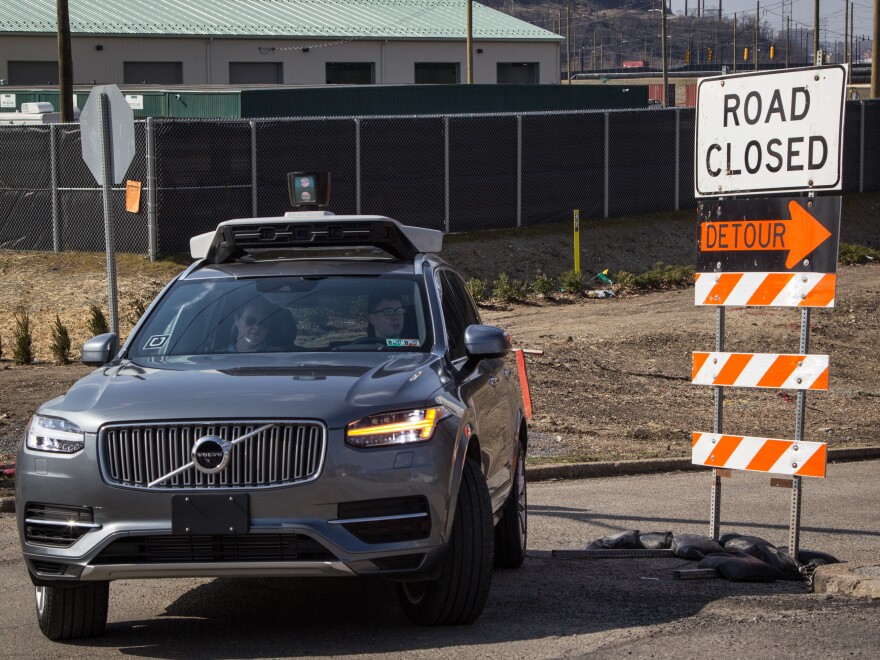Proponents of self-driving cars say they'll make the world safer, but autonomous vehicles need to predict what bicyclists are going to do. Now researchers say part of the answer is to have bikes feed information to cars.
A few years ago on Google's campus, Nathaniel Fairfield arranged an unusual lunch break.
He asked a bunch of staff to hop on bikes and ride around and around a self-driving car to collect data. "It was kind of gorgeous," he says.
Fairfield is the principal software engineer for Waymo, the self-driving car company that began life in 2009 as a Google project. By tracking a flock of cyclists, Waymo's cars were learning how bikes move through the world. But that's not enough.
"You want to predict what they're going to do next," he says. That's something Waymo's vehicles have learned to do over 1 billion simulated miles of testing and 3 million miles of driving themselves.
It's a skill that allows the cars to "fend for themselves," an idea Fairfield says has long motivated his work.
"The robot has to take the world on on the world's terms," he says. "Solve the problems they need to solve out there, and then bring themselves back."
One of the Waymo's primary challenges was biking, now the fastest growing commuting choice in the United States. According to the U.S. Department of Transportation, nearly 1,000 cyclists were killed in car crashes in 2015, the most recent year for which data was available; 45,000 were injured.
Waymo's cars are programmed to pass bikes in accordance to state laws, usually with three feet of clearance. And if they can't do it, they'll just wait.
"Cyclists, like pedestrians, are some of the most vulnerable road users," Fairfield says. "And so we do want to treat them with extra caution and care."
That kind of patience hasn't been lost on cyclists in Pittsburgh, one of three places where Uber is testing its fleet of self-driving cars. Bike Pittsburgh, a local cycling and pedestrian nonprofit, surveyed people about how they felt sharing the streets with the company's gleaming gray Volvos.

"Honestly, I was predicting that people would be a bit more reluctant to ride around them or would be a little more critical of them," says Eric Boerer, Bike Pittsburgh's advocacy director. "People did feel much more comfortable riding next to autonomous vehicles than they did next to human vehicles. I mean, autonomous vehicles, they don't get angry, they don't have road rage."
The technology that helps make self-driving cars unemotional and conservative is showing up in today's cars: Forward collision warning or automatic braking systems help cars talk to one another and avoid collisions. But Anthony Rowe says cars could use a little help when it comes to detecting cyclists.
"Cars have a very regular pattern with the way they move, whereas when people are riding bicycles they change between either acting like cars on the side of the road," says Rowe, an associate engineering professor at Carnegie Mellon University. "They might switch and become pedestrians and go up on the sidewalks. They tend to move in a slightly more erratic way. It's much harder to predict."
Rowe wants to make it possible for bikes to feed information to cars, now and in the fully autonomous future.
"What we're trying to do is put as much instrumentation on a bike as we can to see if we can predict how it's going to move in the future, so that it could, for example, signal a collision warning system on a car," he says.
On a recent afternoon, Rowe pedaled a white Bianchi Brava bicycle up and down a busy street in the city's university district. His bike was loaded with gear: the antenna of a GPS unit extended above his head in a long plastic tube, a laser range finder called a LIDAR measured the precise position of everything around the bike, four inertial measurement units captured motion, a water bottle held a battery, a computer collected all that information, and every other spoke carried a speedometer.
"I would not be happy if I had to ride this every day," says Rowe, hopping off the bike. "But hopefully when all of this stuff just gets embedded in a cellphone on the front, then it should be no problem."
It's all meant to help Rowe and his team figure out the exact position of the bike in the world at all times, so that nearby cars can use that information to drive more conservatively.
They're working backward. First, they want as much data as they can get to figure out the exact position of the bike in the world at all times. Then they'll figure out the least amount of data a car would need from a cyclist for it to trigger an automatic braking system.
"Even hundreds of milliseconds helps," he says. "Because if a car is going to slam on the brakes, it'll slow down dramatically by the time it crashes into you."
Rowe thinks self-driving cars will make the future a lot safer for cyclists and pedestrians. But while humans remain the primary pilots, he thinks a little help from bikes could compensate for their weaknesses.
Margaret J. Krauss is member station WESA's reporter for Keystone Crossroads, an initiative that covers problems facing Pennsylvania's cities and possible solutions.
Copyright 2021 90.5 WESA. To see more, visit 90.5 WESA. 9(MDAxNzg0MDExMDEyMTYyMjc1MDE3NGVmMw004))


